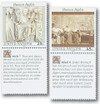
# UN582-83 - 1990 Human Rights
These stamps feature the second group of six Articles of the Universal Declaration of Human Rights. Each piece of art was adapted as a stamp by Rocco J. Callari and Robert Stein of the United States.
On December 10, 1948, the General Assembly unanimously adopted the Universal Declaration of Human Rights. For the first time in history, responsibility for the protection and pursuit of human rights was assumed by the international community. While the United Nations Postal Administration’s Human Rights Series is based upon the Declaration, it does more than commemorate a document signed over 40 years ago. It publicizes a living and continuing standard of conduct for every government to abide by with respect to all people under their jurisdiction.
The 25¢ issue features Article Seven. The artwork is a fragment from the Sarcophagus of Platinus, and was provided by the Vatican Museums. The 45¢ issue has Article Eight with artwork by Charles Paul Renovard, France, made available by the Jewish Theological Seminary of America.
These stamps feature the second group of six Articles of the Universal Declaration of Human Rights. Each piece of art was adapted as a stamp by Rocco J. Callari and Robert Stein of the United States.
On December 10, 1948, the General Assembly unanimously adopted the Universal Declaration of Human Rights. For the first time in history, responsibility for the protection and pursuit of human rights was assumed by the international community. While the United Nations Postal Administration’s Human Rights Series is based upon the Declaration, it does more than commemorate a document signed over 40 years ago. It publicizes a living and continuing standard of conduct for every government to abide by with respect to all people under their jurisdiction.
The 25¢ issue features Article Seven. The artwork is a fragment from the Sarcophagus of Platinus, and was provided by the Vatican Museums. The 45¢ issue has Article Eight with artwork by Charles Paul Renovard, France, made available by the Jewish Theological Seminary of America.











